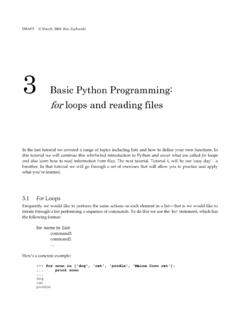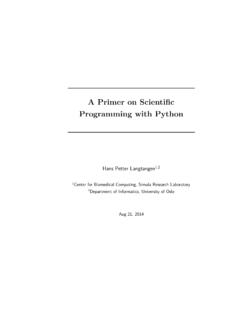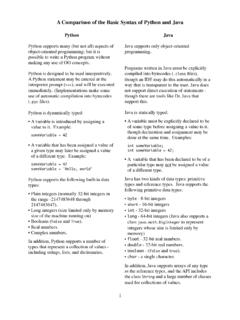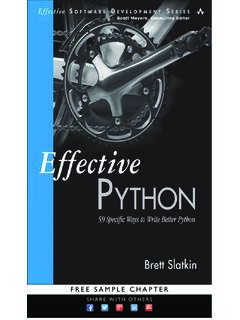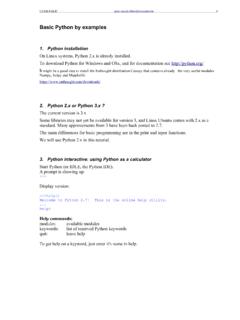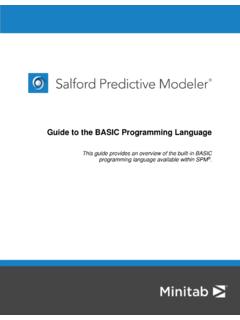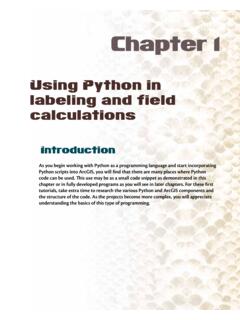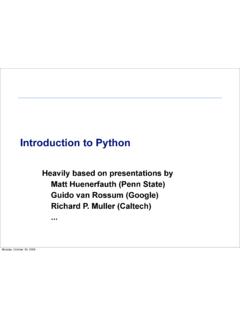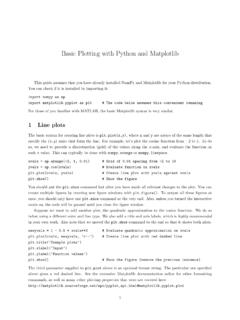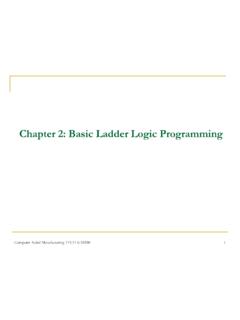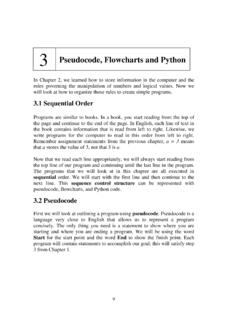Transcription of Basic Python Programming: Lists, and defining functions
1 DRAFT March 4, 2004 Ron Zacharski 2 Basic Python programming : lists , and defining functions First, congratulations on completing tutorial 1! Frequently the little details of beginning to learn a programming language trip a person up and it s great to be over the first hurdle. My goal is to get you doing programming related to linguistics as quickly as possible. With this in mind, the next few tutorials will focus on the essentials of Python you ll need. This is not a comprehensive description of Python . My choice of what material to present is primarily based on providing you with a solid foundation that will enable you to do interesting linguistic stuff. However, occasionally I will throw in Python tidbits that are just intended to spice things up.
2 For example, in this tutorial I ll introduce you to a function that will pick a random noun from a list of nouns. This will allow us to write a little random sentence generator and make practicing the essentials a little more interesting. Names and Values In tutorial 1 we worked with two types of values: numbers and strings and we saw how we could assign names to these (you can follow along by typing these statements in the PythonWin Interactive Window): >>> a = 5 assign the name a to the value 5 >>> b = 7 assign the name b to the value 7 >>> c = a + b first determine the value of the right side of the equation (a + b 5 + 7 12) and assign it the name c >>> c now find out the value of c 12 >>> lemma = 'walk' DRAFT March 4, 2004 Ron Zacharski >>> past_tense = lemma + 'ed' >>> past_tense 'walked' >>> We can assign the name to a new value at any time.
3 >>> linguist_on_duty = 'Ann' >>> linguist_on_duty 'Ann' The value of linguist_on_duty is currently Ann >>> linguist_on_duty = 'Sara' >>> linguist_dn_duty 'Sara' Now the value is Sara >>> linguist_on_duty = 'Ray' >>> linguist_on_duty 'Ray' And now Ray When we assign a name to a new value we can have the name appearing on the right hand side as well as on the left: >>> visitors = 1 The value of visitors is 1 >>> visitors = visitors + 1 First evaluate the right hand side. The current value of visitors is 1; 1 + 1 is 2; so assign 2 to be the new value of visitors >>> visitors 2 >>> visitors = visitors + 2 Evaluate the right hand side first.
4 The current value of visitors is 2; 2 + 2 is 4; so assign 4 to be the new value >>> visitors 4 >>> >>> on_duty = 'Ann' >>> on_duty 'Ann' >>> on_duty = on_duty + ' and Sara' The current value of on_duty is Ann so on_duty + and Sara becomes Ann + and Sara >>> on_duty 'Ann and Sara' >>> Let s look at one more example. >>> staff = 'Ann' >>> on_duty = staff >>> staff = staff + ' and Sara' What are the values of staff and on_duty? >>> staff 'Ann and Sara' DRAFT March 4, 2004 Ron Zacharski >>> on_duty 'Ann' lists ! Let s look at another data type: lists . As the name suggests, a list is an ordered collection of objects. lists are delimited by square brackets ([ ]) and the individual list elements are separated by commas.
5 Start the PythonWin Environment and type the following in the Interactive Window: >>> my_test_scores = [83, 97, 90, 86] As you can see, lists can contain numbers. They can also contain strings: >>> linguists = ['Ann', 'Ben', 'Clara', 'Polly', 'Sally'] >>> computerists = ['Jake', 'Kim', 'Bill', 'Lori'] or both: >>> stuff = ['the', 14, 'an', 27] A list can even contain other lists : >>> sentence = [ ['the', 'dog'], 'saw', ['the', 'cat']] Here the sentence list contains three elements: ['the', 'dog'] the first element is a list containing two elements 'saw' the second element is a string ['the', 'cat'] the third element is a list containing two elements A list can also be empty: >>> to_do_list = [] Accessing elements in a listAccessing elements in a listAccessing elements in a listAccessing elements in a list For some inexplicable reason, computer science types like to start counting from zero (zero, one, ).
6 The person who developed Python (Guido van Rossum) is no exception. So, the index of the first element of a list is not 1 , as you might expect, but 0 . To access an element in a list you use square brackets after the name: >>> linguists[0] the 0th element of the list linguists 'Ann' >>> linguists[2] the 2th element of the list linguists 'Clara' >>> sentence[0] ['the', 'dog'] (Here the first element of the sentence list is itself a list, ['the', 'dog']) DRAFT March 4, 2004 Ron Zacharski You can also use the same square bracket operator to get sublists: >>> linguists[1:4] linguists one through three ['Ben', 'Clara', 'Polly'] Again, for mostly inexplicable reasons, computer science types don t like counting the last number in a range.
7 So [1:4] gives the 1st, 2nd and 3rd elements, but not the 4th because the upper bound is not included. If there is no number on the right side of the colon the range goes to the end of the list: >>> linguists[1:] linguists one to the end ['Ben', 'Clara', 'Polly', 'Sally'] If there is no number on the left side of the colon the range starts at the beginning of the list: >>> linguists[:2] linguists from the beginning to two ['Ann', 'Ben', 'Clara'] You can see all the elements of list by using the name of the list: >>> my_test_scores [83, 97, 90, 86] What happens if you use an index that is larger than the number of items in the list? >>> linguists[10] Traceback (most recent call last): File "<interactive input>", line 1, in ?
8 IndexError: list index out of range Python complains that the index is out of range (the index is larger than the size of the list). Checking if something is a member of a Checking if something is a member of a Checking if something is a member of a Checking if something is a member of a list Is Polly on the linguist list?Is Polly on the linguist list?Is Polly on the linguist list?Is Polly on the linguist list? You can find out whether an item is in a list by using the in function: >>> 'Polly' in linguists Is Polly in the list linguist? True >>> 'Steve' in linguists False ( True is Python s way of saying yes and False is its way of saying no ) DRAFT March 4, 2004 Ron Zacharski The length of a listThe length of a listThe length of a listThe length of a list How Many linguists are there?
9 How Many linguists are there?How Many linguists are there?How Many linguists are there? You can find out how many elements there are in a list by using the length function, len: >>> len([1, 2, 3, 4, 5]) 5 >>> len(linguists) 5 >>> len(computerists) 4 Concatenating listsConcatenating listsConcatenating listsConcatenating lists You can concatenate lists (join two lists ) by using the + operator: >>> [1, 2, 3] + [4, 5, 6] [1, 2, 3, 4, 5, 6] >>> project_members = linguists + computerists >>> project_members ['Ann', 'Ben', 'Clara', 'Polly', 'Sally', 'Jake', 'Kim', 'Bill', 'Lori'] >>> len(project_members) 9 A review of listsA review of listsA review of listsA review of lists So that s the quick 3-page overview of Python lists .
10 Here s a little review. You can either do this by typing the statements in PythonWin or by figuring this out in your head. Let s say you have the following lists : >>> linguists = ['Ann', 'Ben', 'Clara', 'Polly', 'Sally'] >>> computerists = ['Jake', 'Kim', 'Bill', 'Lori'] >>> classes = ['syntax', 'morphology', 'pragmatics'] What s the answer to (you may want to cover the answers with a piece of paper): Answers classes[1] 'morphology' a = classes[1:] a has the value ['morphology', 'pragmatics'] a[1] 'pragmatics' linguists[2] 'Clara' classes = classes + ['phonology'] classes has the value ['syntax', 'morphology', 'pragmatics', 'phonology'] len(classes) 4 len(a) 2 'morphology' in classes True 'morphology' in linguists False 'morphology' in [] False DRAFT March 4, 2004 Ron Zacharski What would you write in order to: Answers assign the name head to the first element in the computerists list.
